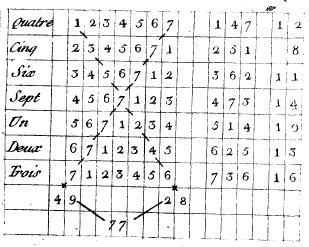kwaw
It should be noted that there is no mention of Tarot in the lengthy description of his book. Also, I believe the translation from the French should say "The astrology of "Le Science Kabbalistique" was inspired, in part, by the works of Etteilla and of his disciple, Melchoir d'Odoucet . . ."
Lenain mentions Etteilla three times in the book, and Odoucet once with direct reference to the books:
Philosophie des Hautes-Sciences by Etteilla (1785 edition)
la Science des signes by Odoucet.
Quote
Le génie*(a) contraire est nommé Terre Morte ou Terre Damnée*(b), suivant l expression d'Etteilla, dans sa Philosophie des Hautes-Sciences, page 83. Il est le plus cruel et le plus traître qui soit connu; il influe sur les infanticides et les parricides.
p.72
Monsieur d'Odoucet, successeur d'Etteilla dans son ouvrage intitulé la Science des signes, troisième partie, page 65, dit positivement "que la révolution des génies" sur les ans, sur les mois sur les semaines, sur les jours "et sur les heures, se fait de 72 en 72 depuis la création.(1)"
p.34/35
(1) : Voyez Etteilla, dans sa Philosophie des Hautes-Sciences, p 66 édition de 1785.
note 1: p.35
Translation
The genius* (a) is otherwise named Dead Earth or Cursed Earth* (b), following the expression of Etteilla, in his Philosophy of High Sciences, page 83. It is the cruellest and most treacherous that is known, it influences infanticide and parricide.
p.72
Etteilla's successor, Mr. d'Odoucet, in the third volume of his Science of signs, , page 65, says positively that "the revolution of geniuses" of the year, the months of the week , on the day "and hours, recur (in cyles) of 72 to 72 since creation. (1)"
p.34/35
(1): See Etteilla, in his Philosophy of the High-Sciences, p 66 edition of 1785.
Note 1: p.35
Kwaw
notes
(a) - In this section Lemain is writing about the angel RHOAL (resh, hey, ayin, aleph, lamed).
(b) - Terre damnée (cursed earth) is an alchemical term: used to refer to 'burnt earth', according to, for example, one of the oldest known alchemical texts LES ENTRETIENS DU ROI CALID, ET DU PHILOSOPHE MORIEN alias De compositione alchemiae, quem edidit Morienus Romanus Calid regi Aegyptiorum Sur le magistère d’Hermès, rapporté par Galip, Esclave de ce Roi (first trans. from arabic into latin c.XIIth century):
La Terre fétide reçoit aussi fort promptement les étincelles blanches et elle empêche que dans la cuisson le Sang ne soit changé et réduit en Terre damnée, c'est à dire, qu'il ne soit brûlé. (Damned earth, i.e., it is burned.)
It is also refered to as lucifer, the fixed salt hidden in the centre of Venus-Aphrodite. Also to the useless or fecal matter left over from a substance that has been purified, or the remnants in a vessel after distillation.


